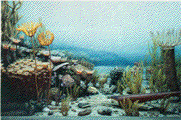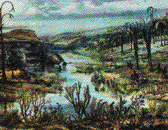The Devonian Mass Extinction

Fast Facts
- Devonian period ranged from 408-360
million years ago
- A major intra-Devonian extinction occurred at the
Frasnian-Famennian boundary
Geological Setting
 Following the Ordovician mass extinction rediversification of surviving groups occurred throughout the Silurian and Devonian. In addition, the Devonian saw the first appearance of sharks, bony fish, and ammonoids. During the Devonian the world's oceans were dominated by reef-builders such as the stromatoporoids, and corals, and some of the world's largest reef complexes were built. Terrestrial newcomers in the Devonian included amphibians, insects, and the first true land plants, giving rise to the first forests.
Following the Ordovician mass extinction rediversification of surviving groups occurred throughout the Silurian and Devonian. In addition, the Devonian saw the first appearance of sharks, bony fish, and ammonoids. During the Devonian the world's oceans were dominated by reef-builders such as the stromatoporoids, and corals, and some of the world's largest reef complexes were built. Terrestrial newcomers in the Devonian included amphibians, insects, and the first true land plants, giving rise to the first forests.
Species Affected
The Devonian mass extinction occurred during the latter part of the Devonian at the Frasnian - Famennian boundary. The crisis primarily affected the marine community, having little impact on the terrestrial flora. This same extinction pattern has been recognized in most mass extinctions throughout earth history. The most important group to be affected by this extinction event were the major reef-builders including the stromatoporoids, and the rugose, and tabulate corals. This late Devonian crisis affected these organisms so severely that reef-building was relatively uncommon until the evolution of the scleractinian (modern) corals in the Mesozoic era. Among other marine invertebrates, seventy percent of the taxa did not survive into the Carboniferous. Amongst the severely affected groups were the brachiopods, trilobites, conodonts, and acritarchs, as well as all jawless fish, and placoderms.
 Causes of the Devonian Extinction
Causes of the Devonian Extinction
 Mass Extinctions of the Phanerozoic Menu
Mass Extinctions of the Phanerozoic Menu
 Main Menu
Main Menu